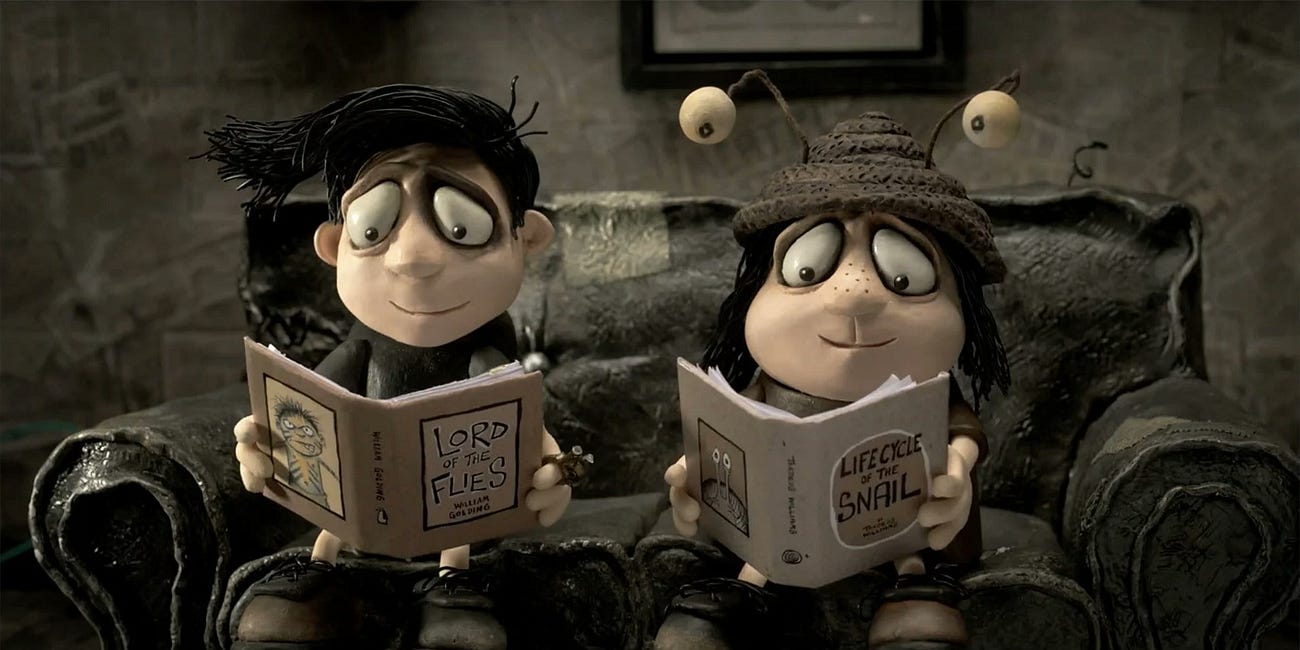MOVIE REVIEW: The End (dir. Joshua Oppenheimer, 2024)
'I think it's a myth...I think it's a myth'
If you were to build a completely artificial life, of course that life would be a musical. At least, that is the impression I get when I listen to the vast majority of filmmakers. In Joshua Oppenheimer’s (The Act of Killing, The Look of Silence), The End, the famed documentarian turns to the artificiality of the musical in order to examine how a wealthy social circle, isolated in their luxury bunker, cope with the belief that they are the only survivors of a climate apocalypse.
The film’s premise is relatively simple, Mother (Tilda Swinton), Father (Michael Shannon), and Son (George MacKay) live in a bunker deep within a system of abandoned salt mines, joining them are Mother’s Friend (Bronagh Gallagher), Butler (Tim McInnerny), and their Doctor (Lennie James). They spend their days trying to recreate normal bourgeois life: with endless redecorating, memoir writing, ersatz holiday celebrations, and security preparations incase of fire or intrusion from the outside. When Girl (Moses Ingram) falls into the mine, the family must face the truths of the narratives they have told themselves in order to avoid the reality of their own isolationism.
If you read this summary and you get the feeling that, The End, is setting itself up to be two and a half hours of tedious and impotent social commentary a la, Triangle of Sadness (2022), then you are not alone. That is exactly how I felt when I first saw the trailer a few weeks ago. So, it goes without saying that, especially after the experience I had with Mickey 17 a few weeks ago, I entered, The End, with a little trepidation. Having now seen the film, however, I am delighted to report that, not only do I think The End is a fantastic work of social commentary, but I can also confidently say that it is a film of the year contender.
I’ve touched on it briefly already, but what we have with, The End, is a film concerned with the stories one tells about themselves, both in a situation where they have a blank slate to start from, and when they need to justify their own survival of their own small group over any one else. George MacKay’s character was born in the bunker, he is, in turn, an empty vessel for everyone around him to project onto. He is under-socialised and uncritical of whatever he is told, be that his mother’s tales of dancing with the Bolshoi Ballet, or the sanitised version of American history he is taught and which he meticulously constructs into a diorama complete with happy Chinese Union Pacific Railroad workers. MacKay’s naivety is what allows the characters around him to impose their idealised version of themselves onto him, and he plays this role wonderfully. He is a social freak, and because stories are his essential to his understanding of the world and to his exploration of human emotion, he seems to pursue the most detailed and intensely personal anecdotes out of everyone he speaks to. What this does is generate a really strange tension where something very stark and blunt (the death of a child to cancer) will be asked about in the manner that a child demanding a bedtime story. It’s never spoken outright, but it is hinted in some throw away dialogue and lyrics that Son is being groomed to be the last person on Earth. Maybe, on some level, they optimistically have some hope that the fires which rage above ground will have dissipated by the time Son becomes the patriarch of the bunker, but it is very clear that Swinton and Shannon’s characters are concerned with leaving him an image of themselves which has been curated and doctored into compelling fiction. Shannon, in particular, uses MacKay’s character in order to justify his own role, as an oil tycoon, in the climate collapse. His memoir being full of fictional philanthropy and downplaying his violent suppression of rioters in Indonesia. The details of the narratives shift and morph, and MacKay comes to pick them apart to reveal the insecurities and the survivor’s guilt which motivates the stories. Grand narratives constructed to cope with the fact that they could have saved more people but didn’t for whatever personal, petty, and selfish reasons.
The arrival of Moses Ingram into the film, this intercession from the outside, reveals the absurdity of everything. We are introduced, prior to her appearance, to the idea that the inhabitants of the bunker at some point were attacked by outsiders and this has cultivated an isolationist paranoia and violent security practices. The more I reflect on the film, the more apparent it is to me that their discussed plans to return Ingram to the surface are innuendos referring to her murder. There is no surface in the film that we see. The burning flame of the waste furnace mimicking light being cast from the entrance to the cave. What I believe to be the darkest element of the film, as it progresses, is the way in which there is an inversion of how one might expect this narrative to develop. The film is not about Moses Ingram’s Girl entering as an obstruction from the outside and altering the social structure of the bunker, but about Ingram conforming to the bunker’s social codes in order to survive. The incursion does not damage the system but is fully assimilated into it. The tragedy of her story, how her actions on the surface have caused the death of her family, is constantly under attack from the others, especially from Swinton’s character who is herself guilty of abandoning her own family. She must learn to keep quiet and morph herself into a reflection of Mother as the ideal wife for Son and to continue that cycle with him. Notice how, when you watch the film, like all good systems of discipline and punishment, the characters are more than willing to ignore the lies and use the truth to cudgel each other back into appropriate behaviour.
This social violence, which evokes how cult members describe keeping each other in line, is what lead me to remark later that the film felt as though it was one transgressive act away from being Peter Greenaway (The Draughtsman’s Contract, A Zed and Two Naughts) does Jacques Demy (The Umbrellas of Cherbourg, The Young Girls of Rochefort). Anyone familiar with either of those director’s will know what I mean. On the surface there is this deeply neurotic attention to detail, in the narrative this is manifested in the form of Tilda Swinton’s neurotic repositioning of painting and her redecorating of the main room, but it is in the form of the film directly. There are dozens of meticulously composed shots involving mirrors, reflecting the characters from all sorts of disorientating angles. You could paint, and someone should, several of the lingering images of Tilda Swinton. It is posed but not staid. Yet there is an undercurrent of violence haunting the whole feature. It just doesn’t, and this isn’t a negative just a difference, explode into violence the way a Greenaway movie often does. Instead, it explodes into musical fantasia. The salt mines functioning almost as the soundstage fantasy sequence during the Broadway Melody in Singing in the Rain. They are really quite magical, especially once Michael Shannon starts tap dancing with Tim McInnerny. It is the performative nature of these numbers, their Hollywood gloss and rehearsed choreography which ramp up the artificiality of the film to its most extreme, and the things which the characters are repressing start spilling outwards. It perfectly colours these violent and shameful desires with a sense of magic, and that perversion possibly more sickening than any violence Oppenheimer could have shown. This tension is thrilling. So weird as to be ecstatic.
The End, is a movie we should be grateful exists. Even if it is too difficult, or too weird for you to enjoy. Perhaps, in these dark times you don’t want to see something so rich with political satire. But, The End, represents a turn for filmmaking that looks to uncover what there is left in the musical form that we can use to add to the complexity of narrative and social critique. Spearheaded by some wonderful performances, and a willingness on everyone’s part to follow such a weird idea down to its nth degree, I don’t think we are going to see another film like it this year. It’s early days, for sure, but I’m fairly confident that I’ll be thinking of, The End, for a long time to come.
Ryan Sweeney (@thecautiouscrip / insta: teawithzizek)
Other Reviews:
MOVIE REVIEW: Flow (Dir. Gints Zilbalodis, 2024)
What do: a cat, a golden retriever, a capybara, a ring-tailed lemur, and a secretary bird have in common? Gints Zilbalodis’s new animated feature film, Flow (2024), brings these animals together in a desperate fight for survival against the rising tides. While the lack of any dialogue may raise concerns for any parent considering taking their children t…
MOVIE REVIEW: Memoir of a Snail (dir. Adam Elliot, 2025)
Memoir of a Snail, the latest feature from claymation heartbreak maestro, Adam Elliot (Mary and Max, Harvie Krumpet) is obviously a mini-marvel of a film. A painstakingly handcrafted world that exists on an aesthetic axis between the ghoulish creatures inside Lon Chaney’s mind and
MOVIE REVIEW: The Brutalist (dir. Brady Corbet 2024)
Is it possible for a film to dream our failed utopias for us? Should it even try? These are the questions that arose while I watched Brady Corbet’s 215 minute epic, The Brutalist. Ultimately, I believe these are the questions which the period drama must ask of itself if it is ever to reconcile itself with a present it is engaged in unavoidable conflict …
MOVIE REVIEW: I'm Still Here (Dir. Walter Salles, 2025)
Walter Salles’s historical-drama, I’m Still Here, based on the memoir, Ainda Estou Aqui, by Marcelo Rubens Paiva, is probably the Academy Award Best Picture nominee least familiar to the general filmgoing audience. Nominated for Best Picture, Best Foreign Language Feature, and Best Actress,








